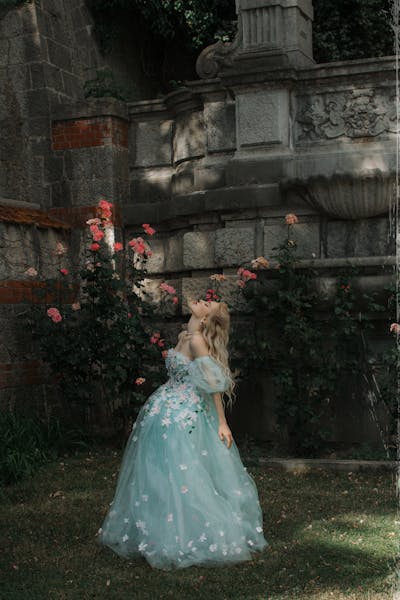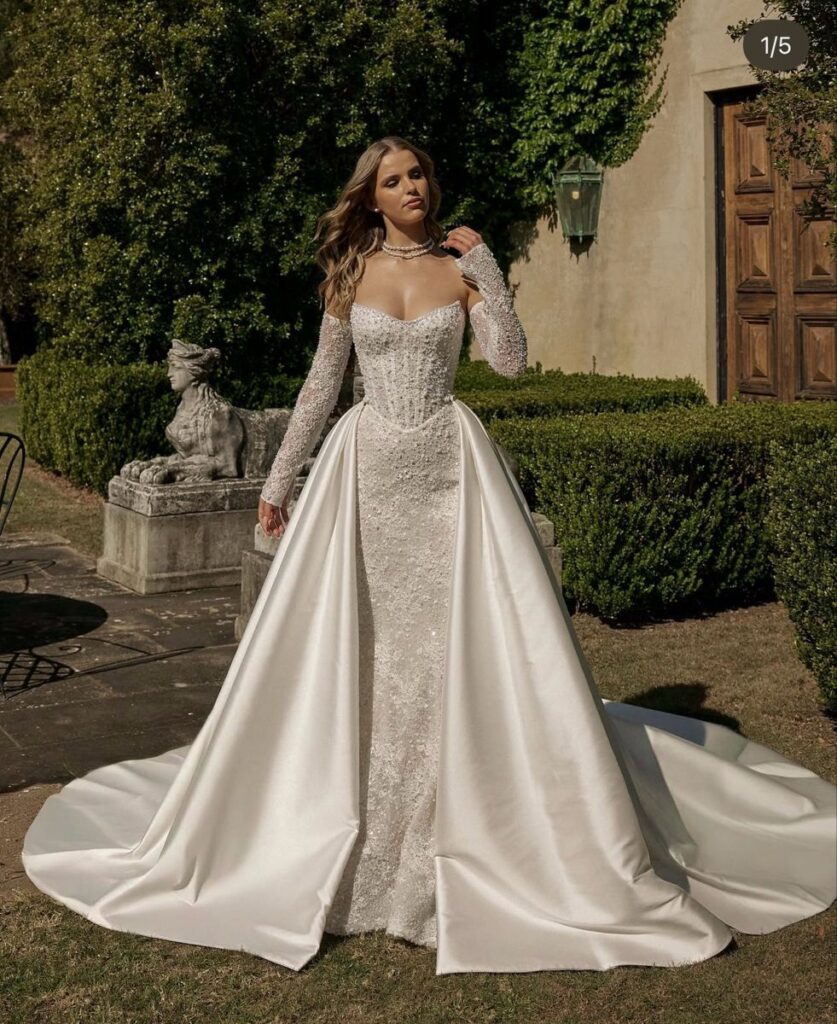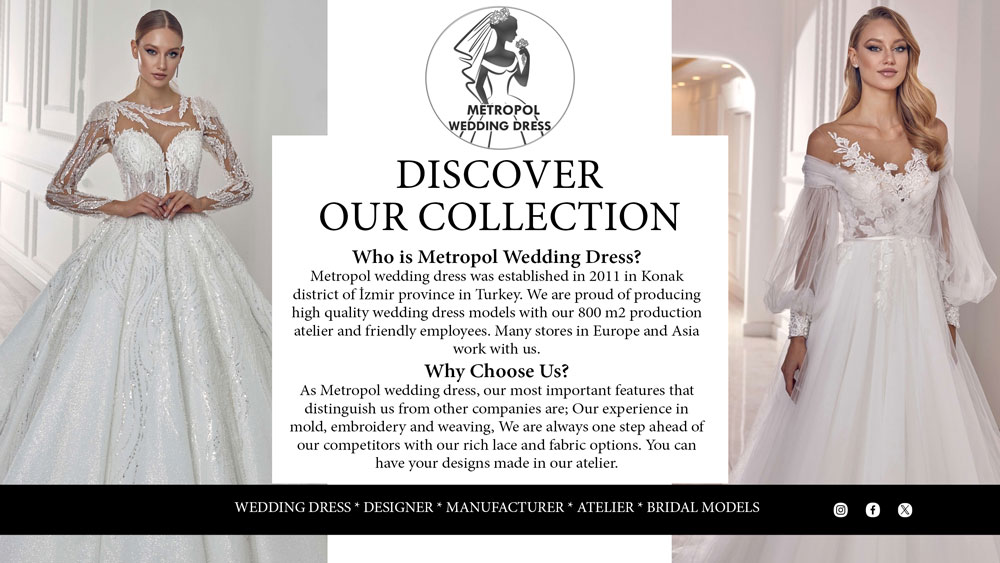
Wholesale Wedding Gowns for Boutiques Timeless Beauty Wedding gowns are the epitome of elegance, romance, and celebration. For bridal boutiques, offering a curated selection of wholesale wedding gowns that embody timeless beauty is essential to meet the dreams of every bride. This comprehensive guide explores the world of wholesale wedding gowns, diving into their design, trends, sourcing strategies, and the business of providing stunning dresses to boutiques. From understanding the needs of modern brides to selecting suppliers and marketing strategies, this article serves as a definitive resource for boutique owners aiming to excel in the bridal industry.
The Importance of Timeless Beauty in Wedding Gowns
Timeless beauty in wedding gowns transcends fleeting trends, offering designs that resonate with brides across generations. These gowns combine classic silhouettes, luxurious fabrics, and intricate details to create an enduring appeal. For boutiques, stocking timeless gowns ensures a collection that remains relevant and desirable year after year.
Defining Timeless Beauty
Timeless beauty in wedding gowns is characterized by elegance, simplicity, and sophistication. Think of iconic designs like Grace Kelly’s 1956 wedding dress or Audrey Hepburn’s minimalist yet chic gown. These dresses avoid overly trendy elements, focusing instead on:
- Classic Silhouettes: A-line, ball gown, and sheath styles that flatter a variety of body types.
- Luxurious Fabrics: Satin, silk, lace, and tulle that exude quality and refinement.
- Subtle Details: Delicate embroidery, pearl embellishments, and soft draping that add charm without overwhelming the design.
Why Boutiques Should Prioritize Timeless Designs
For bridal boutiques, timeless gowns offer several advantages:
- Broad Appeal: They attract a wide range of brides, from traditional to modern.
- Longevity: Unlike trendy designs, timeless gowns remain in demand, reducing inventory obsolescence.
- Versatility: These dresses pair well with various accessories, allowing brides to personalize their look.
By focusing on timeless beauty, boutiques can build a reputation for offering gowns that make every bride feel like a classic vision of elegance.
Understanding the Wholesale Wedding Gown Market
The wholesale wedding gown market is a dynamic sector, with suppliers catering to boutiques worldwide. Understanding this market is crucial for boutique owners to make informed purchasing decisions and stay competitive.
The Role of Wholesale in Bridal Boutiques
Wholesale purchasing allows boutiques to acquire gowns at lower costs, enabling competitive pricing while maintaining healthy profit margins. Key aspects include:
- Bulk Buying: Purchasing multiple gowns to benefit from discounted rates.
- Diverse Suppliers: Working with manufacturers, designers, or distributors to access a variety of styles.
- Customization Options: Some wholesalers offer made-to-order or customizable gowns to meet specific boutique needs.
Key Players in the Wholesale Market
The wholesale wedding gown market includes:
- Designers and Brands: Established names like Vera Wang or Pronovias offer wholesale collections to boutiques.
- Manufacturers: Factories in countries like China or Vietnam produce high-quality gowns at competitive prices.
- Distributors: Middlemen who connect boutiques with multiple brands, offering a one-stop shop for inventory.
Trends Shaping the Wholesale Market
While timeless beauty remains a cornerstone, the wholesale market evolves with subtle trends that boutiques should monitor:
- Sustainability: Eco-friendly fabrics and ethical production practices are gaining traction.
- Inclusivity: Gowns designed for diverse body types and cultural preferences are in demand.
- Minimalism: Clean lines and understated elegance are popular among modern brides.
By staying attuned to these trends, boutiques can balance timeless appeal with contemporary demands.

Wholesale Wedding Gowns for Boutiques Timeless Beauty
Choosing the perfect gowns for your boutique requires a strategic approach. The goal is to curate a collection that reflects timeless beauty while meeting the preferences of your target market.
Understanding Your Clientele
Before selecting gowns, analyze your boutique’s customer base:
- Demographics: Are your brides young, mature, budget-conscious, or luxury-focused?
- Preferences: Do they prefer classic, bohemian, or glamorous styles?
- Cultural Influences: Are there specific traditions or customs that influence their choices?
This understanding guides your selection, ensuring your inventory resonates with your audience.
Evaluating Gown Quality
Quality is non-negotiable in wedding gowns When sourcing wholesale, assess:
- Fabric: Look for premium materials like silk, chiffon, or high-quality lace.
- Construction: Check for sturdy stitching, seamless linings, and proper boning.
- Finishing: Ensure embellishments are securely attached and zippers glide smoothly.
High-quality gowns enhance your boutique’s reputation and reduce returns or complaints.
Balancing Variety and Cohesion
A successful collection offers variety while maintaining a cohesive aesthetic. Consider:
- Silhouette Mix: Include A-line, mermaid, ball gown, and sheath styles to cater to different body types.
- Price Range: Stock gowns at various price points to accommodate diverse budgets.
- Color Options: While white and ivory dominate, consider blush, champagne, or subtle pastels for variety.
This balance ensures your boutique appeals to a broad clientele without diluting its brand identity.
Sourcing Wholesale Wedding Gowns
Finding reliable wholesale suppliers is critical to building a stunning inventory. This section explores sourcing strategies and best practices.
Working with Reputable Suppliers
To ensure quality and reliability, partner with trusted suppliers. Tips include:
- Research: Read reviews, check ratings, and seek recommendations from other boutique owners.
- Sample Orders: Request samples to evaluate quality before committing to large orders.
- Communication: Choose suppliers with clear communication and responsive customer service.
International vs. Local Suppliers
Both international and local suppliers have pros and cons:
- International Suppliers:
- Pros: Lower costs, vast selection, and access to unique designs.
- Cons: Longer shipping times, potential customs issues, and language barriers.
- Local Suppliers:
- Pros: Faster delivery, easier communication, and support for local economies.
- Cons: Higher costs and potentially limited variety.
Weigh these factors based on your boutique’s needs and budget.
Negotiating with Suppliers
Effective negotiation can secure better prices and terms:
- Bulk Discounts: Request discounts for large or recurring orders.
- Payment Terms: Negotiate flexible payment schedules, such as partial upfront payments.
- Exclusivity: Seek exclusive rights to certain designs in your region to differentiate your boutique.
Building strong relationships with suppliers fosters long-term collaboration and mutual success.
Designing a Timeless Wedding Gown Collection
Curating a collection that embodies timeless beauty requires creativity and strategy. This section offers insights into designing a cohesive and captivating inventory.
Key Elements of a Timeless Collection
A timeless collection should include:
- Iconic Silhouettes: A-line and ball gowns that flatter most figures.
- Neutral Tones: White, ivory, and soft pastels that suit various skin tones.
- Classic Details: Lace appliqués, pearl beading, and subtle embroidery for elegance.
Incorporating Modern Touches
While prioritizing timelessness, subtle modern elements can enhance appeal:
- Detachable Features: Overskirts or sleeves that allow brides to switch looks.
- Open Backs: Elegant cutouts or illusion backs for a contemporary edge.
- Lightweight Fabrics: Flowy chiffon or tulle for comfort and ease of movement.
These touches keep your collection fresh without sacrificing classic charm.
Seasonal Considerations
Adapt your collection to seasonal demands:
- Spring/Summer: Lightweight gowns with floral lace or airy tulle.
- Fall/Winter: Richer fabrics like velvet or gowns with long sleeves and higher necklines.
This ensures your inventory aligns with brides’ wedding plans.
Marketing Wholesale Wedding Gowns
Effective marketing is essential to attract brides and showcase your timeless collection. This section covers strategies to elevate your boutique’s visibility.
Building a Strong Brand Identity
Your boutique’s brand should reflect timeless elegance. Key steps include:
- Logo and Aesthetics: Use soft colors, elegant fonts, and romantic imagery.
- Mission Statement: Emphasize your commitment to timeless beauty and personalized service.
- Store Ambiance: Create a warm, inviting space with luxurious decor.
Digital Marketing Strategies
Leverage online platforms to reach brides:
- Website: Build a user-friendly site with high-quality gown images and clear pricing.
- Social Media: Share stunning gown photos, bride testimonials, and behind-the-scenes content on Instagram and Pinterest.
- SEO: Optimize your website with keywords like “timeless wedding gowns” and “bridal boutique.”
In-Store Experience
The in-store experience is crucial for converting visitors into customers:
- Personalized Consultations: Train staff to offer tailored recommendations and attentive service.
- Trunk Shows: Host events to showcase new collections and attract local brides.
- Accessories: Offer veils, jewelry, and shoes to complete the bridal look.
A memorable experience encourages word-of-mouth referrals and repeat business.

Challenges in the Wholesale Wedding Gown Industry
The bridal industry is rewarding but not without challenges. Understanding these hurdles helps boutiques navigate the market effectively.
Inventory Management
Balancing stock levels is tricky:
- Overstocking: Ties up capital and risks unsold inventory.
- Understocking: Limits options and frustrates customers.
Use inventory management software to track sales trends and optimize stock.
Competition
The bridal market is competitive, with boutiques vying for the same customers. Differentiate by:
- Unique Offerings: Exclusive gown designs or customizations.
- Exceptional Service: Superior customer care that creates loyal clients.
- Niche Focus: Catering to specific markets, like plus-size or eco-conscious brides.
Economic Fluctuations
Economic downturns can impact wedding budgets. Counter this by:
- Affordable Options: Stock budget-friendly gowns without compromising quality.
- Flexible Financing: Offer payment plans to ease financial strain.
- Value-Added Services: Include alterations or styling consultations to enhance perceived value.
The Future of Wholesale Wedding Gowns
The bridal industry is evolving, and boutiques must adapt to stay relevant. This section explores emerging trends and predictions.
Technology and Innovation
Technology is transforming the bridal experience:
- Virtual Try-Ons: Augmented reality tools let brides preview gowns online.
- 3D Printing: Enables intricate gown details at lower costs.
- AI Design: Helps create personalized gown designs based on bride preferences.
Sustainability and Ethics
Eco-conscious brides are driving demand for sustainable practices:
- Eco-Friendly Fabrics: Organic cotton, recycled polyester, and biodegradable materials.
- Ethical Production: Fair wages and safe working conditions for garment workers.
- Second-Hand Market: Pre-loved gowns as a sustainable option.
Global Influences
Globalization is shaping bridal fashion:
- Cultural Fusion: Gowns blending Western and Eastern design elements.
- Destination Weddings: Lightweight, travel-friendly gowns for beach or overseas ceremonies.
- Inclusivity: Designs celebrating diverse body types and cultural traditions.
By embracing these trends, boutiques can position themselves as forward-thinking leaders in the bridal industry.
Conclusion
Wholesale wedding gowns are the heart of any bridal boutique, and a focus on timeless beauty ensures a collection that captivates brides and stands the test of time. By understanding the market, sourcing high-quality gowns, curating a cohesive collection, and implementing savvy marketing, boutiques can thrive in the competitive bridal industry. Despite challenges like inventory management and economic fluctuations, the future is bright with innovations like sustainable practices and technology-driven experiences. For boutique owners, the journey of offering timeless wedding gowns is not just a business—it’s a celebration of love, elegance, and dreams come true.
The wholesale wedding gown industry is a vibrant yet challenging sector, where bridal boutiques strive to offer gowns that embody timeless beauty—elegance that captivates brides across generations. While the reward of helping brides find their dream dress is unparalleled, boutique owners face numerous obstacles, from inventory management to fierce competition and shifting consumer demands. This 10,000-word guide explores the key challenges in the wholesale wedding gown industry, offering in-depth analysis and practical solutions to help boutiques thrive. By addressing these hurdles strategically, boutiques can maintain a curated collection of high-quality, timeless gowns that resonate with brides and ensure long-term success.
Inventory Management Challenges
Effective inventory management is critical for bridal boutiques, as wedding gowns are high-value, season-sensitive products. Mismanaging stock can lead to financial strain, lost sales, or an outdated collection that fails to reflect timeless beauty.
Overstocking Risks
Overstocking occurs when boutiques purchase more gowns than they can sell, tying up capital and storage space.
- Financial Impact: Excess inventory locks up funds that could be used for marketing, staff, or new collections. For example, a boutique with $20,000 in unsold gowns may struggle to cover rent or utilities.
- Obsolescence: Even timeless gowns can lose appeal if they remain unsold for multiple seasons, as brides seek fresh designs.
- Storage Costs: Wedding gowns require careful storage (climate-controlled spaces, protective covers), increasing overhead for excess stock.
Solutions:
- Sales Forecasting: Analyze historical sales data to predict demand by silhouette, size, or price point. For instance, if A-line gowns sell 50% faster than mermaid styles, allocate budget accordingly.
- Small Batch Orders: Start with low minimum order quantities (e.g., 5-10 gowns per style) to test market response before committing to larger purchases.
- Inventory Software: Use tools like Square, Vend, or Lightspeed to track stock levels, turnover rates, and reorder points in real time.
Understocking Issues
Understocking, or carrying too few gowns, limits customer options and risks missed sales.
- Lost Opportunities: Brides may leave if they can’t find their preferred style, size, or price range. For example, lacking plus-size gowns could alienate a growing market segment.
- Reputation Damage: A sparse inventory may signal a lack of variety, deterring brides from visiting or recommending the boutique.
- Rush Order Costs: Understocking forces boutiques to place expedited orders, incurring higher shipping or production fees.
Solutions:
- Customer Insights: Use consultation notes, online reviews, or social media polls to identify high-demand styles (e.g., lace A-line gowns with illusion necklines).
- Flexible Suppliers: Partner with wholesalers offering quick turnaround times (e.g., 2-4 weeks) to restock popular gowns as needed.
- Core Inventory: Maintain a balanced baseline of timeless silhouettes (A-line, ball gown, sheath) in popular sizes (4-12) to ensure variety.
Seasonal Inventory Alignment
Wedding gowns are influenced by seasonal trends, complicating inventory planning.
- Seasonal Demand: Spring/summer weddings favor lightweight, airy gowns, while fall/winter ceremonies call for heavier fabrics or long sleeves. Misaligned inventory (e.g., tulle gowns in winter) may not sell.
- Storage Challenges: Off-season gowns require storage, increasing costs and risking damage if not properly maintained.
- Trend Shifts: Even timeless designs evolve subtly (e.g., minimalist gowns gaining popularity), requiring boutiques to refresh inventory without overhauling their aesthetic.
Solutions:
- Seasonal Planning: Allocate 60% of inventory to year-round timeless gowns (e.g., A-line with lace) and 40% to seasonal styles (e.g., long-sleeve satin for winter).
- Rotational Displays: Showcase seasonal gowns prominently while storing off-season styles, reducing clutter and maintaining a fresh look.
- Clearance Sales: Offer discounts on off-season inventory (e.g., summer gowns in fall) to free up space and capital.
Competitive Pressures
The bridal industry is highly competitive, with boutiques, chain retailers, and online platforms vying for the same customers. Standing out while offering timeless gowns requires strategic differentiation.
Local and Regional Competition
Nearby boutiques or department stores can draw brides away if they offer similar gowns or better experiences.
- Price Wars: Competitors may undercut prices, forcing boutiques to lower margins or risk losing sales.
- Similar Inventory: If multiple boutiques source from the same wholesalers, their collections may lack uniqueness, diluting brand identity.
- Marketing Rivalries: Competitors with stronger social media presence or advertising budgets may attract more foot traffic.
Solutions:
- Exclusive Designs: Negotiate exclusivity agreements with suppliers for specific gown designs in your region. For example, secure sole rights to a lace ball gown with pearl detailing.
- Niche Focus: Cater to underserved markets, such as plus-size brides, eco-conscious weddings, or cultural-specific designs (e.g., Indian-inspired gowns).
- Superior Service: Offer personalized consultations, in-house alterations, or styling sessions to create a memorable experience that competitors can’t match.
Online Retail Threats
E-commerce platforms like Etsy, Amazon, or direct-to-consumer brands (e.g., Azazie, Lulus) pose significant challenges.
- Lower Prices: Online retailers often sell gowns at 20-50% less than boutiques due to lower overhead or direct manufacturing.
- Convenience: Brides can browse thousands of gowns online, often with virtual try-on tools or free shipping, reducing the need to visit physical stores.
- Counterfeit Risks: Some online sellers offer knockoffs of designer gowns, misleading brides and undermining boutique credibility.
Solutions:
- Hybrid Model: Develop an online store with high-quality gown images, detailed descriptions, and virtual consultation options to compete with e-commerce convenience.
- Authenticity Emphasis: Highlight the authenticity and quality of your wholesale gowns, emphasizing premium fabrics (e.g., silk, lace) and craftsmanship that online knockoffs lack.
- Value-Added Services: Offer perks like free alterations, custom veils, or bridal party discounts that online retailers can’t replicate.
Brand Differentiation
In a crowded market, boutiques must carve out a distinct identity to attract brides seeking timeless beauty.
- Generic Offerings: Boutiques with similar gown styles or aesthetics may struggle to stand out.
- Marketing Fatigue: Brides are bombarded with bridal ads, making it hard to capture attention.
- Trend Pressure: Balancing timeless designs with modern trends (e.g., open-back gowns) can dilute a boutique’s classic brand.
Solutions:
- Unique Branding: Develop a clear brand identity (e.g., “classic romance” or “vintage elegance”) reflected in your logo, store decor, and gown selection.
- Storytelling: Share the inspiration behind your timeless gowns (e.g., Grace Kelly-inspired designs) through social media, blogs, or in-store displays.
- Community Engagement: Host trunk shows, bridal workshops, or charity events to build local loyalty and differentiate from impersonal competitors.
Economic Fluctuations
Economic conditions directly impact brides’ budgets and purchasing behavior, creating uncertainty for boutiques reliant on wholesale gowns.
Reduced Wedding Budgets
During economic downturns, couples often cut wedding expenses, affecting gown sales.
- Lower Spending: Brides may opt for budget gowns ($500-$1,000) over mid-range ($1,000-$2,500) or luxury ($2,500+), reducing boutique revenue.
- Delayed Weddings: Economic uncertainty may lead couples to postpone weddings, shrinking the customer pool.
- Price Sensitivity: Brides become more price-conscious, comparing boutique prices to online or second-hand options.
Solutions:
- Affordable Options: Stock 30-40% of inventory in budget-friendly gowns with timeless designs (e.g., simple A-line with minimal lace) to attract cost-conscious brides.
- Payment Plans: Offer financing options, such as 50% upfront and 50% over 6 months, to make gowns more accessible.
- Value Proposition: Bundle services (e.g., free alterations, veil with gown purchase) to enhance perceived value without slashing prices.
Rising Wholesale Costs
Economic factors like inflation or supply chain disruptions can increase gown costs.
- Material Costs: Premium fabrics (silk, lace) may rise in price due to global demand or shortages, squeezing margins.
- Shipping Fees: International suppliers may charge higher freight costs due to fuel price hikes or port delays.
- Currency Fluctuations: For boutiques sourcing internationally, exchange rate volatility can inflate costs unexpectedly.
Solutions:
- Local Sourcing: Partner with domestic suppliers to reduce shipping costs and currency risks, even if prices are slightly higher.
- Bulk Negotiation: Secure 10-20% discounts by committing to larger or recurring orders, offsetting material cost increases.
- Price Adjustments: Gradually raise gown prices (e.g., 5-10% annually) to reflect wholesale cost hikes, ensuring margins remain healthy.
Seasonal Sales Variability
Wedding season peaks (spring/summer) and troughs (fall/winter) create cash flow challenges.
- Uneven Revenue: Boutiques may earn 70% of annual revenue during peak months, straining finances during slower periods.
- Inventory Costs: Stocking gowns for peak season requires upfront investment, risking overstock if sales underperform.
- Staffing Needs: Peak seasons demand more staff, while off-seasons may lead to overstaffing.
Solutions:
- Off-Season Promotions: Offer discounts or trunk shows in fall/winter to boost sales of timeless gowns.
- Diversified Revenue: Sell accessories (veils, jewelry) or bridesmaid dresses year-round to stabilize income.
- Flexible Staffing: Hire part-time or seasonal staff during peak months to manage costs.
Supply Chain Disruptions
The wholesale wedding gown industry relies on complex global supply chains, which are vulnerable to disruptions that delay deliveries or compromise quality.
Manufacturing Delays
Production issues at supplier factories can stall inventory replenishment.
- Labor Shortages: Factories in countries like China or Vietnam may face worker shortages, delaying gown production.
- Raw Material Scarcity: Shortages of lace, silk, or beads can halt manufacturing, especially for intricate timeless designs.
- Quality Control Failures: Rushed production may lead to defective gowns (e.g., uneven stitching, loose beads), requiring returns or repairs.
Solutions:
- Multiple Suppliers: Source from 2-3 wholesalers across different regions (e.g., Asia, Europe, USA) to diversify risk.
- Sample Inspections: Request samples before bulk orders to verify quality and consistency.
- Buffer Stock: Maintain a 10-20% surplus of popular gowns to cover delays without disrupting sales.
Shipping and Logistics Issues
Global shipping challenges can delay gown deliveries, especially for international suppliers.
- Port Congestion: Delays at major ports (e.g., Shanghai, Los Angeles) can extend shipping times from 2 weeks to 2 months.
- Freight Costs: Rising fuel prices or container shortages can double shipping fees, eroding margins.
- Customs Delays: Import regulations or documentation errors can hold gowns at borders, delaying restocking.
Solutions:
- Local Suppliers: Allocate 30-40% of inventory to domestic wholesalers for faster, cheaper shipping.
- Expedited Options: Negotiate with suppliers for priority shipping (e.g., air freight) for high-demand gowns, despite higher costs.
- Proactive Tracking: Use supplier tracking systems or third-party logistics tools to monitor shipments and anticipate delays.
Ethical Supply Chain Concerns
Brides increasingly demand ethically produced gowns, creating pressure to vet suppliers.
- Labor Practices: Factories with poor working conditions or low wages risk reputational damage if exposed.
- Environmental Impact: High-carbon production or non-sustainable fabrics (e.g., polyester) may alienate eco-conscious brides.
- Transparency Gaps: Many wholesalers lack clear documentation of their supply chain, complicating ethical sourcing.
Solutions:
- Ethical Certifications: Partner with suppliers certified by organizations like Fair Trade or WRAP (Worldwide Responsible Accredited Production).
- Sustainable Fabrics: Prioritize gowns made with organic cotton, recycled lace, or biodegradable tulle to appeal to green brides.
- Supplier Audits: Request factory audits or visit production sites (in-person or virtually) to verify ethical practices.
Evolving Consumer Expectations
Modern brides have higher expectations, driven by social media, sustainability concerns, and personalization demands, challenging boutiques to adapt while maintaining timeless beauty.
Demand for Sustainability
Eco-conscious brides prioritize sustainable gowns, complicating wholesale sourcing.
- Fabric Concerns: Traditional materials like polyester or mass-produced lace have high environmental footprints.
- Production Waste: Fast-fashion manufacturing generates textile waste, clashing with sustainability values.
- Second-Hand Appeal: Brides may opt for pre-loved gowns from platforms like Stillwhite, reducing demand for new inventory.
Solutions:
- Eco-Friendly Suppliers: Source from wholesalers offering sustainable fabrics (e.g., organic silk, hemp blends) or low-waste production.
- Circular Models: Offer a consignment program for gently used gowns, blending sustainability with timeless appeal.
- Marketing Transparency: Highlight eco-friendly gowns on your website and social media, detailing their materials and production process.
Personalization and Customization
Brides increasingly seek unique gowns tailored to their vision, challenging standard wholesale offerings.
- Custom Requests: Brides may want detachable sleeves, altered necklines, or specific embroidery, requiring flexible suppliers.
- Fit Expectations: Off-the-rack gowns may not fit perfectly, leading to costly alterations or dissatisfaction.
- Cultural Designs: Diverse brides seek gowns reflecting their heritage (e.g., lehenga-inspired details), which generic wholesalers may not offer.
Solutions:
- Customizable Suppliers: Partner with wholesalers offering made-to-order or customizable gowns (e.g., adjustable trains, color options).
- In-House Alterations: Employ skilled seamstresses to handle customizations, adding value and justifying higher prices.
- Diverse Inventory: Stock gowns with cultural elements (e.g., intricate beading for South Asian brides) to meet varied needs.
Social Media Influence
Social media platforms like Instagram and Pinterest shape brides’ expectations, creating pressure to offer photogenic, trendy-yet-timeless gowns.
- Trend Pressure: Brides inspired by viral gown designs (e.g., open-back minimalist dresses) may overlook classic styles.
- Visual Standards: Gowns must photograph well for social media, requiring high-quality fabrics and flattering silhouettes.
- Comparison Shopping: Brides compare boutiques online, expecting competitive pricing and variety.
Solutions:
- Photogenic Gowns: Select gowns with Instagram-worthy details (e.g., flowing trains, delicate lace) that align with timeless beauty.
- Social Media Strategy: Post high-quality gown photos, styled with accessories, and engage followers with polls or giveaways.
- Trend Integration: Incorporate subtle modern elements (e.g., illusion backs) into timeless silhouettes to satisfy trend-savvy brides.
Technological Disruptions
Technology is reshaping the bridal industry, presenting both opportunities and challenges for boutiques sourcing wholesale gowns.
Online Retail Advancements
E-commerce and virtual tools are changing how brides shop, challenging physical boutiques.
- Virtual Try-Ons: Platforms like Anomalie offer augmented reality (AR) try-ons, reducing the need for in-store visits.
- Direct-to-Consumer Brands: Companies like Reformation bypass wholesalers, offering custom gowns at lower prices.
- Price Transparency: Online price comparisons make it harder to justify boutique markups.
Solutions:
- Digital Integration: Offer virtual consultations or AR try-on tools on your website to compete with online convenience.
- Unique Inventory: Stock exclusive, high-quality gowns that online brands can’t replicate, emphasizing craftsmanship.
- Experience Focus: Highlight the tactile, emotional experience of in-store fittings, which online platforms can’t match.
Manufacturing Innovations
Technological advancements in gown production create opportunities but also challenges.
- 3D Printing: Used for intricate embellishments, it lowers costs but may flood the market with mass-produced designs, diluting exclusivity.
- Automation: Automated cutting or sewing reduces production time but may compromise the handcrafted quality of timeless gowns.
- AI Design: AI-generated gown designs may lack the emotional resonance of human-crafted classics.
Solutions:
- Handcrafted Emphasis: Market your gowns as artisanal, highlighting hand-sewn lace or bespoke details that automation can’t replicate.
- Selective Innovation: Partner with suppliers using 3D printing for unique, cost-effective embellishments that enhance timeless designs.
- Quality Control: Inspect gowns rigorously to ensure technological advancements don’t compromise craftsmanship.
Data Management Needs
Technology demands robust data systems to manage inventory, sales, and customer preferences.
- System Costs: Implementing inventory or CRM software (e.g., Zoho, Shopify) requires upfront investment and training.
- Data Security: Storing customer data (e.g., measurements, budgets) risks breaches if not properly secured.
- Skill Gaps: Staff may lack the tech skills to leverage data analytics for inventory decisions.
Solutions:
- Affordable Tools: Use cost-effective platforms like Square or Google Analytics to track sales and customer trends.
- Cybersecurity Measures: Invest in secure cloud storage and regular software updates to protect data.
- Staff Training: Provide basic tech training to ensure staff can use data tools for inventory forecasting or personalized marketing.
Conclusion
The wholesale wedding gown industry is fraught with challenges, from inventory management and fierce competition to economic fluctuations, supply chain disruptions, evolving consumer expectations, and technological disruptions. Yet, these obstacles are not insurmountable. By adopting strategic solutions—such as data-driven inventory planning, niche differentiation, ethical sourcing, and digital integration—bridal boutiques can navigate these hurdles while maintaining a focus on timeless beauty. A collection of high-quality, elegant gowns, thoughtfully curated to meet brides’ dreams, ensures boutiques remain resilient and relevant. In overcoming these challenges, boutiques do more than sell dresses—they create unforgettable experiences, weaving timeless beauty into the fabric of every bride’s story.






